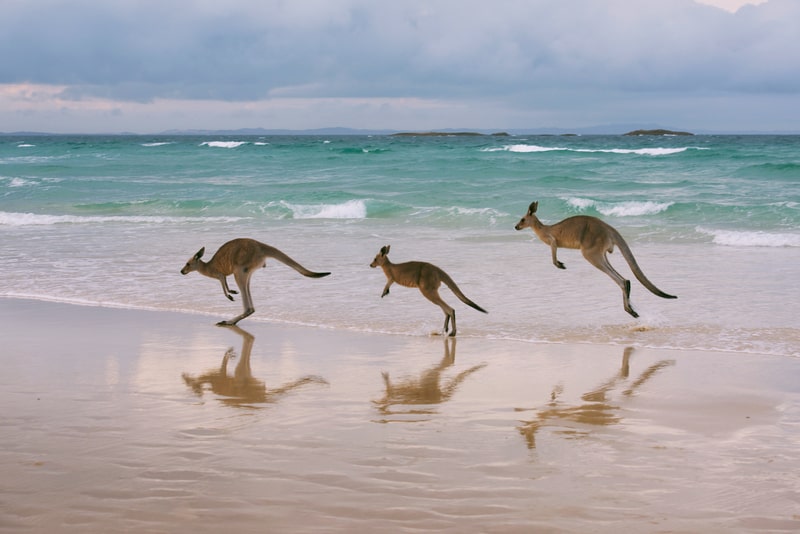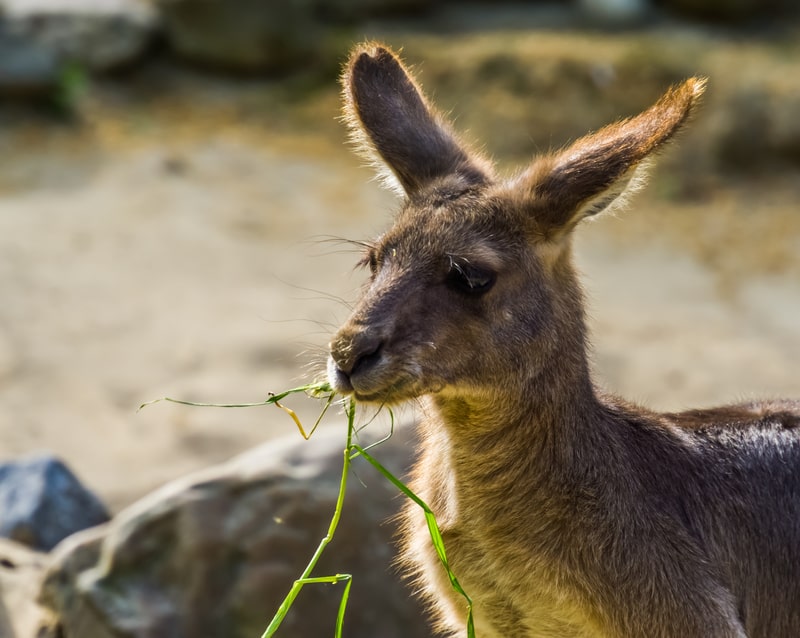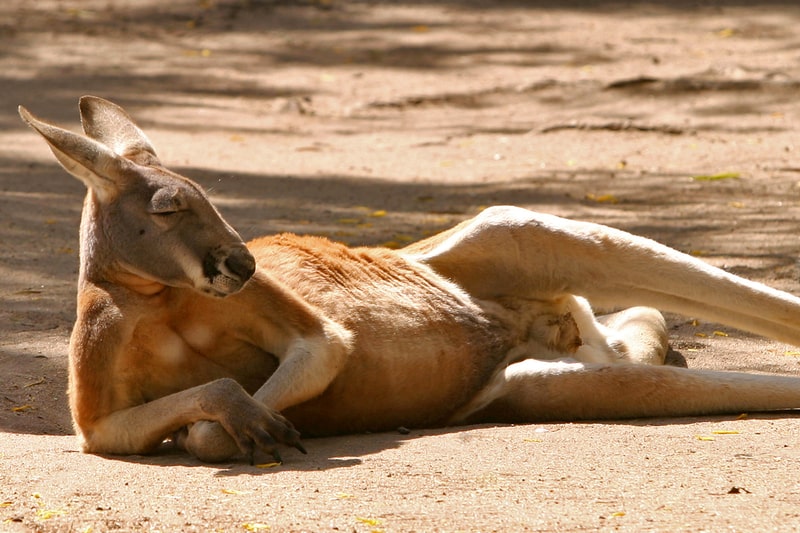Last updated on May 31st, 2023
Most people know that a kangaroo is a large animal that hops around Australia on two feet and carries a baby in her front pouch. However, most people do not know very much about this intriguing animal beyond those basics. For example, both male and female kangaroos have complex reproductive systems that are baffling to scientists. In addition, the reason a kangaroo hops instead of walking might surprise you.
49 Interesting facts about Kangaroos
60 Species
1. Some sources claim that there are upwards of 60 different species of kangaroos, while others say there are as few as four species. This discrepancy is because kangaroos are macropods, a grouping that encompasses wallabies, bettongs, and many other animals. The largest of the macropods are kangaroos, of which there are only five variations: red kangaroos, antilopine kangaroos, eastern gray kangaroos, western gray kangaroos, and tree kangaroos.
Did you know about the tree kangaroo?
2. Tree kangaroos are most dissimilar from the other types of kangaroos. According to the World Wildlife Fund, there are 13 tree kangaroo species. With considerably smaller bodies, shorter legs, and even more arm strength, they have evolved to live in the trees as they did centuries ago. Additionally, they walk on all four legs and do not hop.
Australia – always moving forward
3. The Commonwealth Coat of Arms of Australia shows a kangaroo beside an emu as they hold up a shield. Just like kangaroos, emus cannot simply move backward. According to the Australian Government Department of the Prime Minister and Cabinet, the image represents the nation always moving forward.

Buck
4. A male kangaroo is commonly referred to as a buck, boomer, or jack.
Doe
5. A female kangaroo may be called a doe, flyer, or jill.
Lifespan
6. A kangaroo does not have a very long lifespan in the wild. Its average lifespan is only about five years, but it can live up to 25 years in captivity, such as in a zoo or animal sanctuary.
Herbivores
7. Kangaroos are herbivores who prefer grass, flowers, ferns, fruit, leaves, and moss. Some even eat certain insects.
One step further
8. After their initial meal, kangaroos will regurgitate their food to chew once more before swallowing it for good.

A little water is all they need
9. Kangaroos do not need very much water to survive. In fact, they can last for months on end without a single sip of liquid. Like giraffes, they get plenty of moisture from the plants they digest, and these sources are enough to sustain them for extended periods.
May be not?
10. However, if kangaroos are desperate for a drink, they have been known to dig deep holes in search of freshwater underground.
Marsupials
11. They are the largest of all marsupials on the planet. Male kangaroos are taller and heavier than the females. The largest kangaroo species have males as tall as 6 feet 7 inches and weighing up to 200 pounds.
Tiny babies
12. Kangaroos give birth after only a few weeks. The babies are known as joeys. When they are born, the joeys are not fully developed. In fact, they are usually only the size of a grape!
In the pouch
13. After birth, the teensy tiny joey crawls through his mother’s fur and finds his way to her front pouch, where he stays for between 7 and 10 months as he finishes developing.
14. Joeys urinate and defecate right in their mom’s pouch. The mother cleans it out using her paws and mouth when she has some free time.

Contact with the outside world
15. Joeys hang out in the pouch with their heads poking out, getting a lay of the land and munching on grass. After a few months, they leave the comfort of their mom to explore for short periods of time. If they sense danger, they will dart back to the pouch and dive in head first.
Pregnancy – on pause
16. Female kangaroos can literally pause a pregnancy if they need to. Since a joey has to remain in the pouch for much longer than in the womb, a female can “freeze” her developing embryo. The new baby will lie dormant in her womb until her current joey is old enough to go out on his own.
A special reproductive system
17. Female kangaroos have mind-boggling reproductive systems that consist of two uteruses and three vaginas per kangaroo. Meanwhile, male kangaroos have two-pronged penises.
18. Despite the differences in reproductive systems, the mating process for kangaroos is the same as most other animals.

Before they mate
19. To see if a female is ready to mate, male kangaroos will sniff a female’s urine and will instinctively know if it is time or if he needs to wait.
Telephony
20. When scared or nervous, kangaroos will either hiss or growl. If females need to communicate with their babies, they make clucking sounds. Additionally, males make noises that sound like chuckles while courting a potential mate.
21. Sometimes, male kangaroos make a sound comparable to a human’s cough. This noise actually signifies that he has come across another male with a higher social status. The grumbling or coughing sound shows the other male that he is obedient and submissive, so there is no need to fight.
Sign of dominance
22. A more dominant male kangaroo will pull up large clumps of grass in front of other males. These actions signify to the other males that he is indeed the alpha.
When together
23. When kangaroos are in groups of ten or more, they are called a court, herd, mob, or troop.

24. These marsupials live in a cluster as small as three or four and as large as more than a hundred.
25. Groups of kangaroos appear to adhere to social structures that are complex and that researchers do not fully understand. Like most structures seen in animals, there is an alpha male in each group who is responsible for leading the group. The alpha maintains exclusive access to females for mating.
Where are they found?
26. There are millions of kangaroos in Australia and New Guinea, which are their native lands. The Australian government can only provide an educated guess that estimates how many there are. As of 2020, the government estimated that over 42.8 million kangaroos were in the wild.
27. In addition to their native lands, feral kangaroos have started populating parts of France, the United Kingdom, and the United States. These instances are believed to be because the animals escaped from a zoo or animal park.
Save energy – save life
28. Kangaroos evolved to perform those powerful jumps that they are known for. Enormous elastic tendons in their back legs allow them to hop with elastic strain energy rather than muscular effort. Fortunately, hopping is an extremely efficient mode of transport. The faster kangaroos can hop, the less energy they use.
Unable to walk
29. Surprisingly, kangaroos can only move their hind legs if they do so in unison. The exception to this is when they are swimming or lying on their side. Otherwise, their legs will not move one at a time, which explains why they cannot walk.
but can hop!
30. Kangaroos can hop as fast as 43 miles per hour for a short time but can cruise for longer distances going 25 miles per hour. As an added bonus, they can even change direction in the air!

31. Red kangaroos specifically can hop more than 25 feet in a single jump.
32. Witnessing two kangaroos meeting for the first time is like seeing a love story unfold. The two kangaroos will sniff each other and sweetly touch noses.
. . . continue reading on the next page
